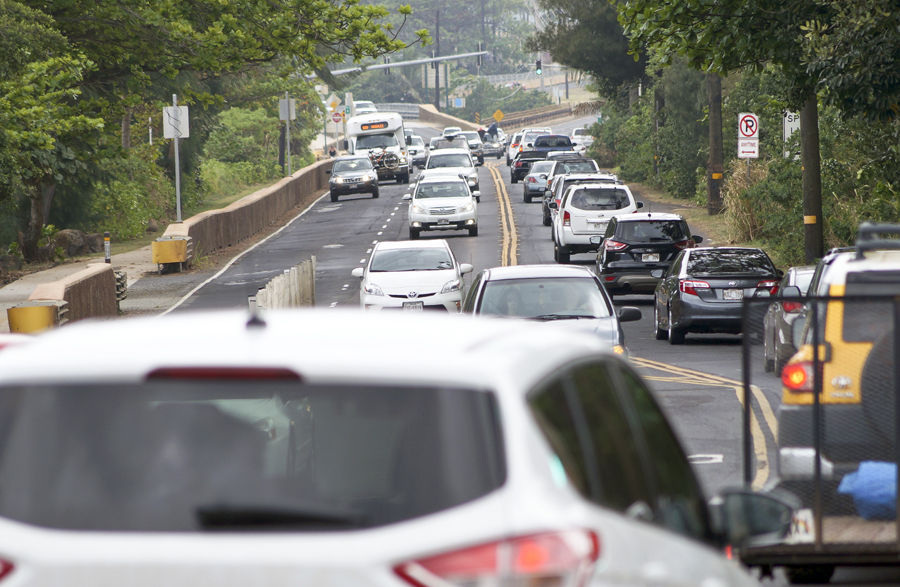LIHUE — There are three multi-million dollar projects that can mitigate traffic in Kapaa. But the problem is they are all state-funded projects, and there’s no money for them. Those projects, which were identified by a team of county and
LIHUE — There are three multi-million dollar projects that can mitigate traffic in Kapaa. But the problem is they are all state-funded projects, and there’s no money for them.
Those projects, which were identified by a team of county and state representatives, as well as commentary from Kapaa residents, are:
• A second southbound travel lane on Kuhio Highway between the Kapaa Bypass and the Wailua River
• A northbound lane on the Kapaa Bypass at the roundabout on Olohena Road
• A second southbound lane on Kuhio Highway from the Wailua River to Kapule Highway.
The Hawaii Department of Transportation is working on environmental studies for each of the three projects, said Lyle Tabata, acting county engineer.
Once the assessments are done, the county can ask for money from the state Legislature.
“The whole process of creating projects, I know it makes everyone crazy with how long it takes, but we cannot go out and build whatever we want to build,” Tabata said. “We have to go through a process, especially when we apply for money from the state.”
Michael Moule, chief of the engineering division, said the projects range in price from $20 million to $43 million, based on current federal aid standards.
Tabata and Moule briefed the Public Works and Parks and Recreation Committee Wednesday at the request of Kauai County Councilman Gary Hooser, who wanted an update on the county’s plans to address the traffic congestion that plagues Kapaa.
There are over 40 construction projects on the Eastside, ranging from road widening to walking and biking improvements. For most of the projects, it is up to the Hawaii Department of Transportation to see the projects through, Tabata said.
“They are primarily along the Kuhio Highway corridor,” he said.
The most significant project is adding a second southbound travel lane on Kuhio Highway between the Kapaa Bypass and the Wailua River, Tabata said.
The project, which was supposed to break ground this year, is now expected to begin in 2018.
A major hangup with the project was a requirement from the United States Fish and Wildlife Service to run utilities underground, which is a significant cost, Tabata said.
But recently, FWS changed the requirement, and utility lines can be built above ground.
In the short-term, HDOT plans to conduct a survey on the stoplights along Kuhio Highway to minimize time delays. On the county side, the administration plans to continue looking for alternatives like developing connecting roads.
“We have ideas for other projects, but funding is one of our biggest stumbling blocks,” Tabata said.
Because funding presents a problem, and officials deemed the county-funded projects identified on the list not able to significantly address congestion, Tabata said he is waiting on the state to get funding before he can move forward with projects.
During the meeting, Hooser and Mel Rapozo, council chair, questioned the priorities of the administration, when it comes to road repair projects.
“Some people may say why can’t we use the TIGER grant money, and use it in places like this,” Hooser said.
Funds from the TIGER grant, which will go toward fixing seven road improvement projects in Lihue have to go specifically to those projects, Tabata said.
But projects on Rice and Hardy Street don’t solve congestion issues, Rapozo said.
He said the administration needs to be just as focused to find a solution to Kapaa traffic as they were when they applied for and received the TIGER grant.
“Are we putting the same resources in motion, using our man power to focus on congestion, which I believe is much more critical than Rice and Hardy Street improvements,” Rapozo said. “Yes, we can always make things look better and nicer, but are we doing whatever it takes to deal with congestion in Kapaa?”
Rapozo also cautioned against waiting to get money from the state to address congestion.
“If we wait, it’s never going to happen,” he said. “Congestion is a Kauai problem, not a state problem, and the solution is more roads.”


